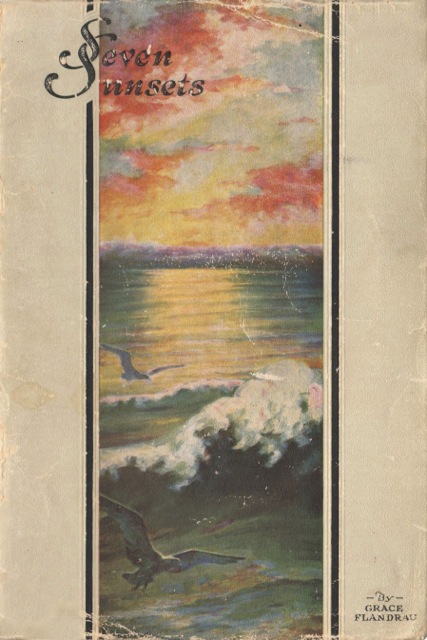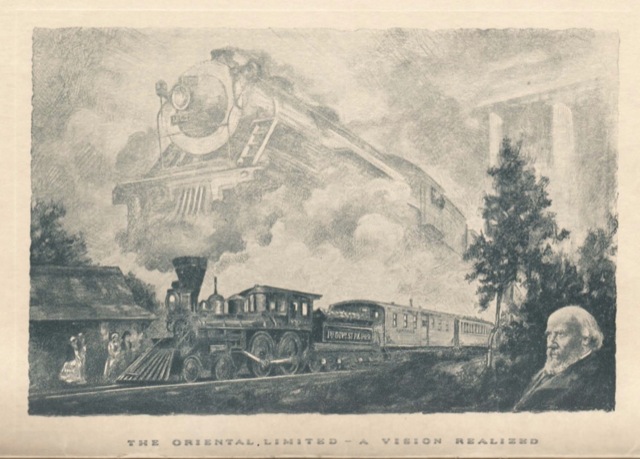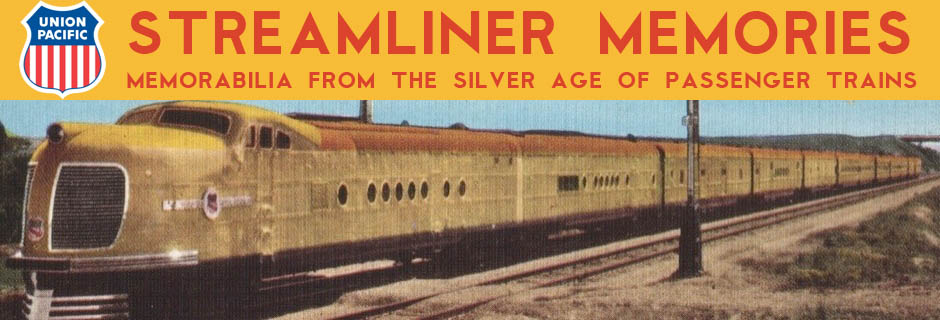Seven Sunsets was the only non-historical essay Grace Flandrau wrote for the Great Northern. Ostensibly a travelogue, it was in fact a 46-page advertisement for the Oriental Limited, which the railway had completely re-equipped in 1924. The source of the title was that someone traveling round-trip from Chicago to the Northwest would see seven sunsets on the two 70-hour train journeys.

Click image to download a 15.5-MB PDF of this 60-page booklet.
In April, 1924, the Great Northern announced that it had purchased eight sets of luxurious new trains from Pullman for the Oriental Limited that would go into service on June 1. The sleeping cars on these trains had “fixed head boards so that the sections take on somewhat the seclusion of compartments,” while the dining cars “are of very heavy construction, making them practically sound and vibration proof.” More important for passenger safety, the cars were of all-steel construction, while the dining and sleeping cars on the previous Oriental Limited had been wood with a steel underframe.
The Oriental Limited‘s 70-hour schedule meant that six trains were in operation nearly all the time, while two more were being readied for the next journey. GN said it also purchased the equivalent of two more trains “to give extra service often desired by the public.” This extra equipment was no doubt used for the historical expeditions. The railway also bought 28 new 4-8-2 oil-burning steam locomotives, at a cost of $2 million, to haul the passenger trains over the mountains.

The embossed frame around this drawing can be discerned on at least two side of this image. Click image for a larger view.
Although Seven Sunsets was the same 6″-by-9″ size as Flandrau’s historical booklets, the Great Northern lavished extra attention on it. The other essays were composed of two kinds of paper: a heavy-duty paper for the cover and somewhat lighter paper for the interior. Seven Sunsets had four kinds of paper: an extra-heavy-duty cover; a heavy-duty inside cover that bore an image of one of GN’s new 4-8-2 locomotives and the William Crooks as a frontispiece; a piece of tissue paper to separate the frontispiece from the title page; and the remaining interior pages of somewhat lighter paper.
The front cover was also embossed with the words “Seven Sunsets,” while the back cover had embossed birds. The frontispiece had an embossed frame around the picture of the locomotives, which is probably why it was made of heavier-duty paper. The tissue paper was probably to protect the embossment, which is a lot of extra effort for something that most people would probably barely notice, especially as the back inside cover was completely blank.
The margins around Seven Sunsets text were a half-inch wider than those of the historical booklets, so the column of text was slightly less than three inches wide compared with four inches in the historical booklets. In some cases the margins contained drawings of mountains, wildlife, and other scenery, but most were simply white space.
The clear message behind all this extravagance was that the Oriental Limited was a first-class train, and not the crude mode of transportation that wealthy Easterners might fear awaited them in the wild West. While most of Flandrau’s historical essays said a few nice things about the Great Northern and James J. Hill, this one is almost exclusively devoted to advertising the train and its route.
The drawings or etchings in the booklet were done in 1924 by Dakota native Levon West. Born in 1900, these were some of the first pieces of art West sold. He made a name for himself in 1927 when an etching he had done of the Spirit of St. Louis was published on the front page of the New York Times. He would go on to sell images of pack horses, Glacier National Park, Venice, the Spirit of St. Louis, and George Washington.
During the Depression, he turned to color photography, selling photos to such publications as the Saturday Evening Post over the name Ivan Dmitri. He also wrote at least a dozen books, mostly on how to take color photos but at least one book of his photos of World War II airplanes. Near the end of his life, North Dakota awarded him the Theodore Roosevelt Rough Rider award, the state’s highest civilian honor.
